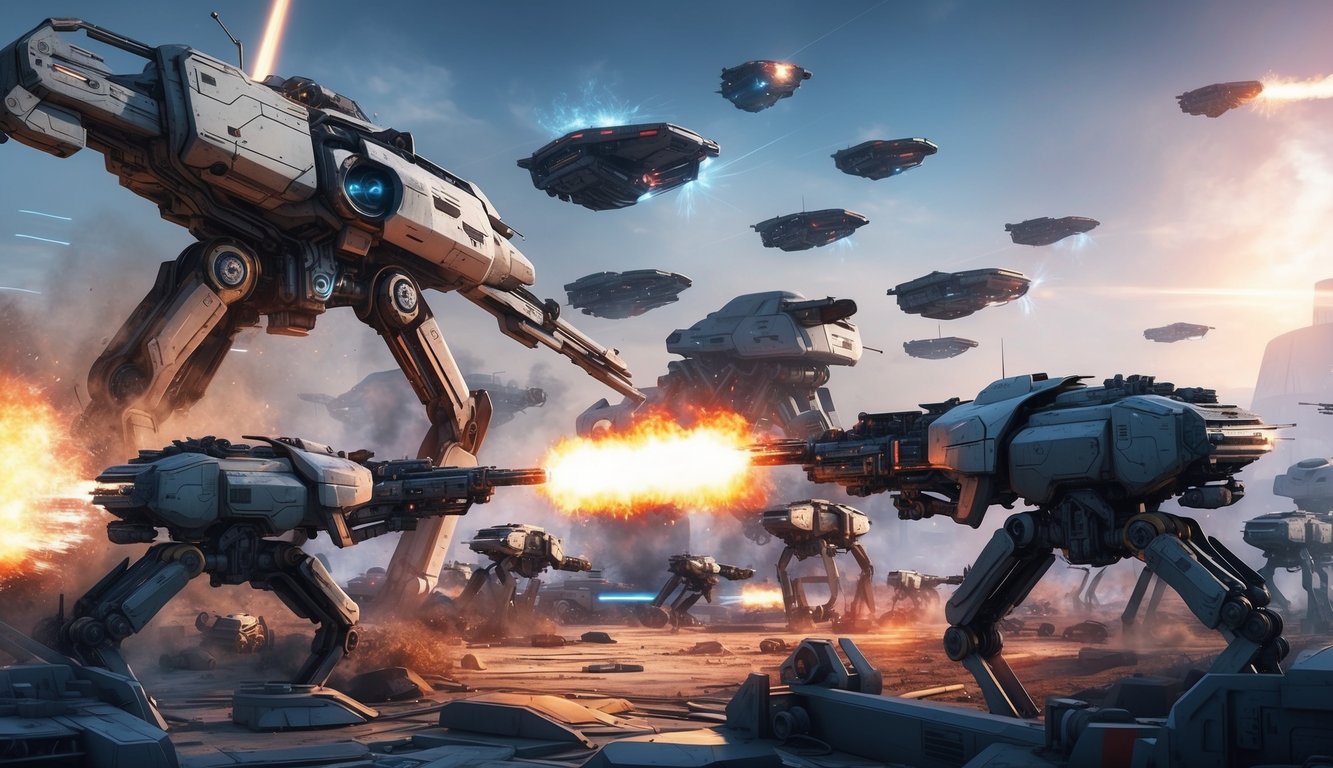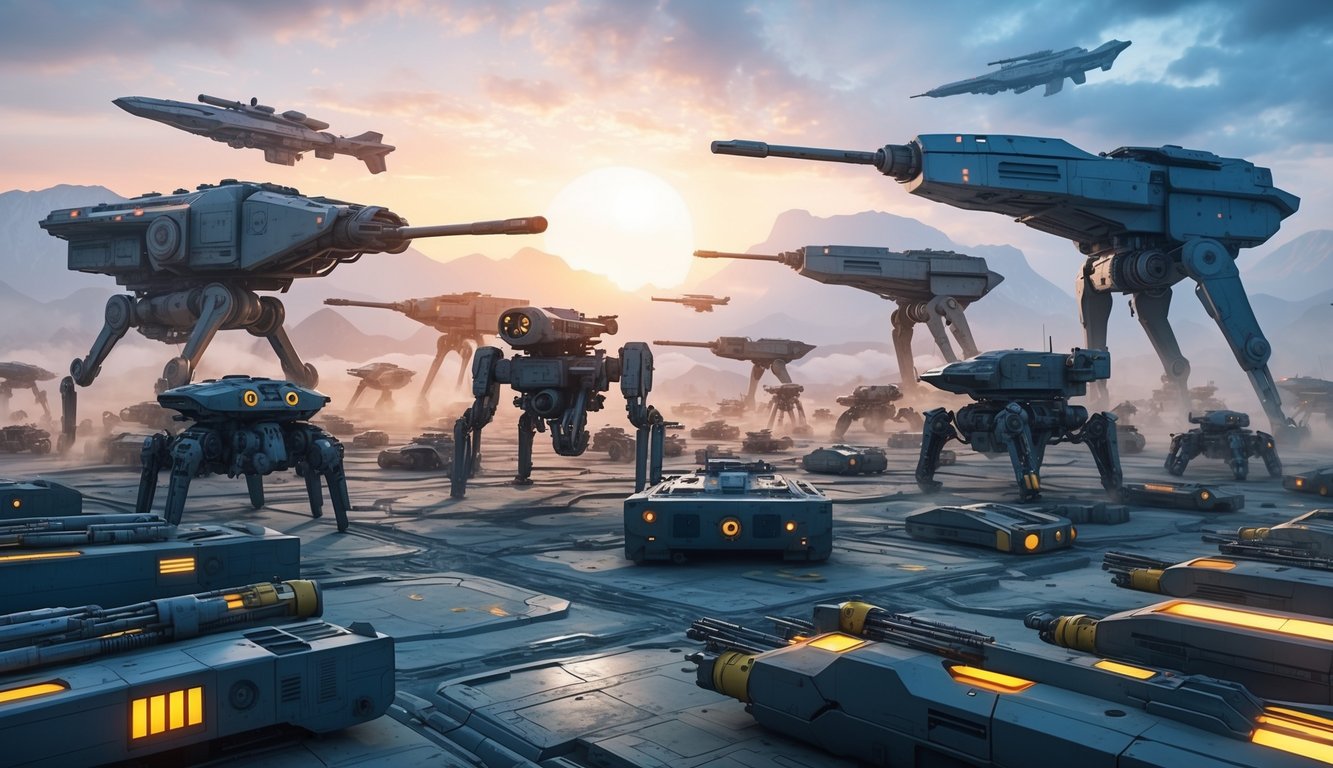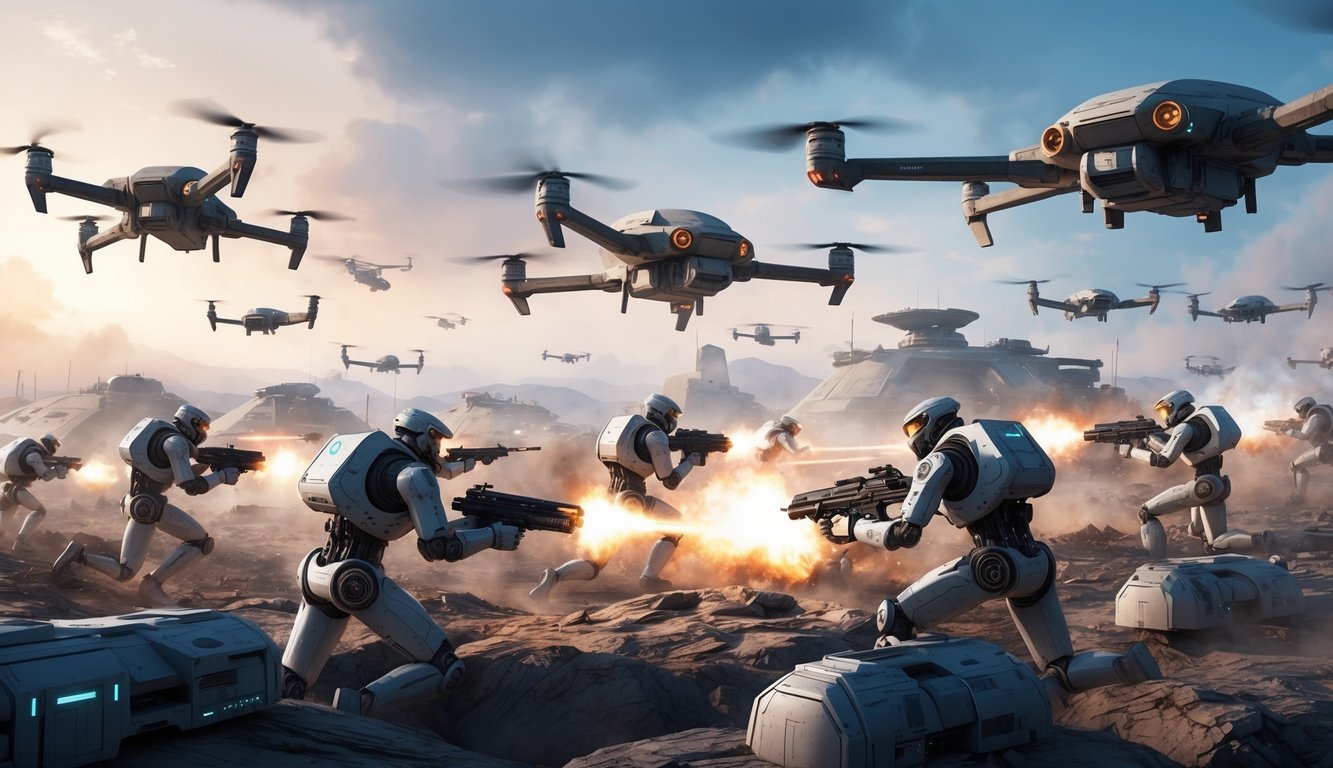“`xml
Warfare is rapidly transforming, with autonomous weapons leading this change.
These advanced AI systems are altering military tactics and bringing forth new ethical dilemmas. Autonomous weapons possess the capability to operate autonomously, making decisions and executing actions without immediate human direction.
As technology progresses, militaries around the globe are heavily investing in autonomous systems.
From self-operating submarines to drone swarms that communicate collaboratively, these weapons enhance military effectiveness while minimizing risks to personnel.
Nevertheless, their development ignites discussions around accountability, legality, and the possibility of unintended outcomes.
The future of warfare might witness machines predominating battlefields, with human oversight evolving into different forms.
Key Takeaways
- Autonomous weapons are transforming military approaches and provoking ethical questions
- Armed forces are investing in AI-driven solutions like self-operating vehicles and drone swarms
- Future conflicts may feature greater machine involvement alongside new types of human oversight
Historical Evolution of Warfare
Throughout history, warfare has seen significant transformations.
Technological innovations have continuously redefined combat, evolving from ancient hand-to-hand confrontations to today’s AI-fueled systems.
From Spears to Drones
Warfare has progressed from rudimentary spears to sophisticated drones.
Early military engagements depended on close combat with simple armaments.
The advent of gunpowder revolutionized warfare, leading to the introduction of firearms and artillery.
The World Wars incorporated tanks, planes, and submarines into combat.
The Cold War saw the emergence of nuclear arms and space technologies.
More recently, precision-guided munitions and unmanned aerial vehicles (UAVs) gained prominence.
Drones have become pivotal in contemporary conflicts, providing intelligence, strike capabilities, and reducing risk for human personnel.
The trend shows a continual increase in the distance between combatants through technological advancement.
The Rise of Machine Learning in Conflict
We now find ourselves in an age where AI and machine learning are redefining warfare.
These technologies enhance decision-making processes, target identification, and logistics optimization.
AI-driven systems can quickly analyze massive data sets, providing tactical advantages.
Machine learning helps anticipate enemy movements and discern patterns in intricate battlefield scenarios.
Autonomous weapons are emerging, capable of selecting and engaging targets with minimal human oversight.
This progression raises ethical challenges and complicates traditional combat conventions.
Furthermore, AI is influencing cybersecurity, electronic warfare, and psychological strategies.
As these technologies evolve, adapting to a new conflict paradigm will be necessary.
The Technology Behind Autonomous Weapons
Autonomous weapons signify a groundbreaking shift in modern warfare, merging state-of-the-art technologies to create systems that function with minimal human intervention.
These advancements are reshaping military capabilities while raising intricate ethical issues.
Artificial Intelligence in Combat
AI serves as the foundation of autonomous weapon systems, enabling rapid data processing and decision-making.
Machine learning algorithms empower these systems to adjust to evolving battlefield conditions.
AI can enhance target identification, enabling weapons to differentiate between combatants and non-combatants.
Additionally, it improves navigation and obstacle avoidance, allowing drones and unmanned vehicles to function effectively in complex settings.
Predictive analytics driven by AI can forecast enemy actions and propose tactical measures.
This technological development aims to minimize human error and speed up reactions in high-pressure combat environments.
Robotics and Drones
Robotics are vital to autonomous weapons, from small reconnaissance drones to larger unmanned ground systems.
These technologies can operate in dangerous scenarios without endangering human lives.
You’ve probably seen footage of quadcopter drones employed for surveillance.
Advanced models are capable of carrying weapons and making targeting choices autonomously.
Robotic sentinels are being designed to protect military facilities, employing sensors and AI for intruder detection.
Unmanned naval vessels are emerging, capable of patrolling vast oceanic regions for extended durations.
These robotic ships can track submarines and potentially engage in combat while uncrewed.
Generative AI and Defense Systems
Generative AI is a recent addition to the realm of autonomous weapons.
It has the potential to develop realistic training simulations, aiding military personnel in preparing for various scenarios.
Generative AI may also assist in crafting new weapon designs, optimizing factors like aerodynamics and payload capacity.
Additionally, it can generate deceptive information to mislead enemy intelligence operations.
In the realm of cybersecurity, generative AI could formulate adaptive defense mechanisms that evolve against emerging threats.
It might also be utilized to devise tactical plans or predict enemy strategies based on historical and current intelligence.
Ethical and Legal Considerations
The emergence of autonomous weapons presents multifaceted ethical and legal dilemmas.
Discussions around human control, accountability, and the evolving nature of warfare become crucial as AI systems gain traction on battlefields.
The Debate Around AI Warfare
AI weaponry ignites fervent debates among military and policy experts.
You might question whether machines should hold the authority to make life-and-death choices.
Critics argue that AI lacks the understanding of combat nuance or adherence to ethical standards, while proponents assert that AI might decrease civilian casualties and offer improved precision compared to humans.
Issues surrounding human rights law are also significant.
Consideration must be given to whether AI weapons infringe upon the right to life or human dignity.
Accountability becomes pertinent – who is liable if an autonomous weapon errs?
Some advocate for a complete prohibition of autonomous weapons, while others propose regulations to ensure human oversight.
The situation is complex and devoid of simple resolutions.
Human Oversight and Responsibility
Recognizing the necessity of human control over AI weapons is paramount.
Most experts concur that some degree of human oversight remains essential.
But what does that entail in practice?
The concept of “meaningful human control” is vital.
This implies that humans should make crucial decisions regarding the deployment of force.
AI-assisted tools can aid in target identification or threat assessment, but a human must ultimately authorize engagement.
This raises questions regarding accountability and the command hierarchy.
If an autonomous weapon inadvertently causes harm, who is responsible? The programmer? The commanding officer? It delves into complex legal territory.
Concerns are also present surrounding the impact of AI weapons on national security.
One must consider how they might alter military strategies and international relations.
Is there a risk that AI weapons could make warfare more likely by diminishing perceived consequences?
International Dynamics
The global landscape of autonomous weapons is evolving swiftly.
Nations are engaged in a race to develop AI-powered military systems, with prominent powers like China and Russia taking the lead.
Recent conflicts, particularly in Ukraine, have demonstrated the practical implications of these technologies.
The Global Arms Race for AI
A high-stakes competition is unfolding as countries pour resources into autonomous weapons development.
The U.S. National Defense Strategy identifies AI as critical to sustaining military superiority.
China has aspirations to become the leading global AI powerhouse by 2030, including military dimensions.
Russia has publicly stated its intent to create AI-driven combat systems.
This race is not just about firepower; it encompasses data, algorithms, and computational capabilities.
Nations are investing extensively in research, attracting leading talent, and in some cases, engaging in cyber espionage for competitive advantage.
Ethical issues abound.
The notion of “killer robots” has ignited international discussions on the necessity of regulations and maintaining human oversight over lethal decisions.
Case Studies: China and Russia
China’s ambitions in military AI are expansive.
They are developing a wide array of technologies, from autonomous submarines to AI-enhanced decision support frameworks for military leaders.
Their focus on “intelligentized warfare” seeks to offset American military advantages.
In Russia, there is a pronounced emphasis on unmanned ground systems and AI-augmented electronic warfare capabilities.
They have trialed autonomous tanks in Syria and are developing swarm technologies for drone deployments.
Both nations perceive AI as a means to compete with U.S. military preeminence, potentially operating with fewer constraints related to ethical considerations, giving them more leeway in weapon development.
Ukraine: Autonomous Systems in Action
The conflict in Ukraine serves as a real-world testing ground for autonomous weapons.
Commercial drones have been modified with AI for reconnaissance and targeting missions.
Ukrainian forces have leveraged facial recognition technology to identify Russian casualties.
Loitering munitions, often referred to as “kamikaze drones,” have been instrumental in operations.
These devices autonomously seek out targets before executing strikes.
This conflict is yielding essential insights into the effectiveness and limitations of current autonomous technologies in real combat situations.
Furthermore, it illustrates the potential for asymmetric warfare, whereby smaller forces can leverage AI to balance the odds against larger adversaries.
The Role of Autonomous Weapons in National Defense
Autonomous weapons are transforming national defense strategies.
While they provide enhanced capabilities and efficiencies, they also bring forth intricate ethical and security concerns.
Let’s examine how they are being incorporated into military operations.
Department of Defense Strategies
The U.S. Department of Defense is actively crafting policies surrounding autonomous weapon systems.
They’ve revised Directive 3000.09, which oversees the development and deployment of these technologies.
This framework ensures that human oversight remains paramount in weapon deployment.
The DoD is prioritizing semi-autonomous systems that necessitate human participation in critical decisions.
These systems are designed to enhance battlefield awareness and responsiveness while upholding ethical standards.
There’s an observable shift toward integrating AI and machine learning across various military applications, encompassing surveillance, logistics, and decision support tools to augment, rather than replace, human capabilities.
Cybersecurity and Autonomous Defense
Autonomous defense systems are becoming increasingly vital in cybersecurity.
They can detect and respond to threats much faster than human operators, establishing a crucial defense line against cyberattacks.
These systems are constantly surveilling networks, discerning anomalies, and initiating countermeasures in real-time, which is essential for safeguarding critical infrastructure and military communications.
However, dependence on AI for cyber defense introduces new vulnerabilities.
Ensuring the integrity and security of these systems themselves remains a top priority for the U.S. military and defense contractors.
Private Sector Partnerships and Innovations
Companies like Palantir are collaborating with the Department of Defense to develop advanced autonomous technologies.
Such partnerships introduce private sector innovations to military challenges.
You’ll observe enhancements in data analytics, machine learning, and AI being leveraged for military operations.
These tools assist in processing extensive information, enabling more effective strategic decision-making.
Partnerships with private enterprises aim to create secure and reliable autonomous systems, which includes establishing robust testing frameworks and addressing potential vulnerabilities prior to deployment.
The future of national defense will likely involve a collaborative approach combining human expertise and autonomous capabilities to reinforce overall security measures.
Future Perspectives

Autonomous weapons are set to drastically change warfare dynamics in the coming decades.
You’ll likely experience profound shifts in military tactics, ethical considerations, and international relations as these systems become more sophisticated and widespread.
Projecting Trends and Potential Scenarios
By 2030, autonomous systems could potentially manage up to 30% of combat operations.
You might witness swarms of AI-driven drones executing reconnaissance tasks or engaging targets with limited human oversight.
Autonomous submarines might conduct prolonged underwater missions.
Ground forces could utilize robotic “mules” for logistics support and firepower.
The skies may feature AI fighter jets that can outmaneuver human pilots.
Such projections bring forth challenging inquiries.
How will rules of engagement adapt? What are the implications if autonomous weapons malfunction or are compromised?
Preparing for Autonomous Armed Conflict
To navigate this evolving landscape, you’ll need to revise your national defense strategy.
Prioritizing counter-AI capabilities and reinforcing critical systems against cyber threats will be essential.
Training programs will require significant updates.
Future military personnel must become adept at collaborating seamlessly with robotic counterparts.
Future war games should integrate scenarios involving autonomous adversaries.
Legally and ethically, you’ll confront difficult choices.
Should the focus be on advocating for international agreements to restrict autonomous weapons? Or should you embrace such technologies to maintain military dominance?
Diplomatic efforts may also require adaptation.
What approaches will work when engaging with nations possessing autonomous weaponry capable of independent operation? New frameworks for de-escalation and arms control will emerge in the realm of AI.
Frequently Asked Questions

Autonomous weapons and AI are set to revolutionize warfare in the coming years.
Important issues to consider include tactical innovations, emerging technologies, ethical questions, and strategic shifts.
How will AI influence the evolution of military tactics by 2030?
AI is expected to facilitate more precise and rapid decision-making on the battlefield.
We can anticipate greater employment of swarm tactics with coordinated autonomous drones.
Predictive analytics may empower commanders to better foresee enemy movements and optimally deploy forces.
AI-enhanced systems could refine situational awareness and targeting precision, potentially resulting in swifter, more lethal engagements with less risk to human personnel.
What new technologies are predicted to dominate future warfare by 2050?
Hypersonic armaments capable of exceeding Mach 5 speeds could become common.
Directed energy weapons, such as lasers, may play a significant role in missile defense and counter-drone efforts.
We can also expect heightened utilization of robotic ground vehicles and unmanned naval vessels.
Advanced AI and quantum computing could pave the way for novel forms of electronic and cyber warfare.
Biotechnology and human enhancement might also influence future conflicts in unforeseen ways.
What role are autonomous weapons expected to play in the next military revolution?
Autonomous weapons are likely to be tasked with more hazardous and monotonous missions.
They may be deployed for reconnaissance, logistical tasks, and force protection.
As AI capabilities advance, autonomous systems might engage in combat scenarios with limited human intervention, potentially lowering casualties for deploying forces but raising ethical concerns.
Their speed and accuracy could condense decision-making timelines, escalating conflict volatility.
How might AI reshape strategic decisions in conflict scenarios?
AI’s analysis of extensive data sets could afford leaders a clearer understanding of adversaries’ capabilities and intentions, leading to more informed strategic decisions.
Wargaming and simulations amplified by AI could unveil unexpected outcomes and strategies.
Increased reliance on AI-generated options for military planning might occur.
The capacity to quickly analyze information could give rise to new deterrence measures rooted in predictive analysis.
What are the ethical implications of deploying autonomous weapons in war?
Key considerations include accountability for autonomous actions leading to civilian casualties and the challenges of ensuring meaningful human control compliant with warfare laws.
Debates may arise regarding whether autonomous weapons lower the threshold for initiating armed conflict; some believe they could alleviate human suffering, while others voice concerns over indiscriminate usage.
The potential for autonomous weapons to be utilized by malicious entities introduces further ethical dilemmas.
What do military experts predict about the integration of AI in war by the year 2050?
Many experts envision AI as a means of augmenting human decision-making rather than replacing it entirely.
Integrating AI across all warfare domains is likely.
Some predict AI will enable innovative forms of conflict that do not align with traditional warfare definitions.
Concerns about uncontrolled escalations in AI-versus-AI confrontations are also prevalent.
Experts generally agree that AI will prove essential for retaining military advantages, though opinions diverge on the level of autonomy that should be permitted.
“`

